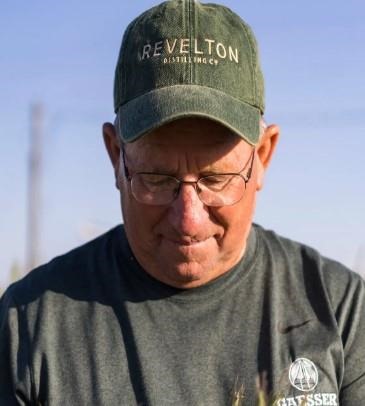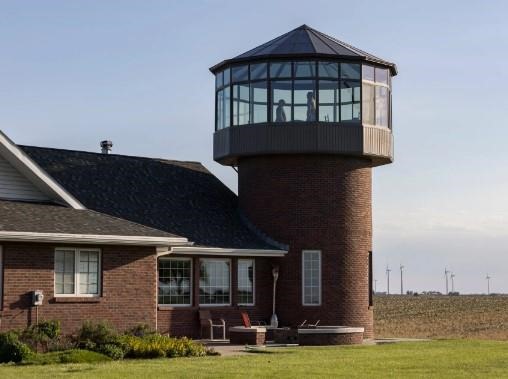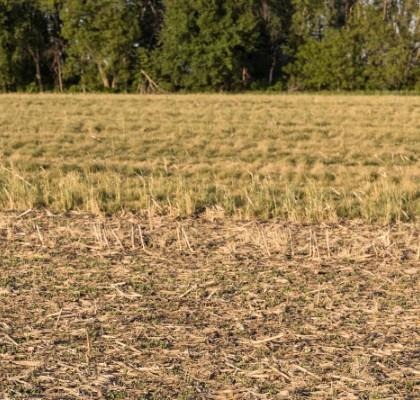By Julie Creswell
Driving rain pelted the windows of “the Tower,” a second-story glass enclosure in Ray Gaesser’s home that provides a view for miles of the gentle, rolling fields around Corning, Iowa. Inside, away from the elements, Mr. Gaesser pondered what the coming year might bring for farmers.
As tractors and planters throughout the Midwest rolled into fields like the ones near his house earlier this year, Mr. Gaesser, 69, was hopeful that soaring grain prices and heightened global demand for food would translate into robust revenues. But he also expected that sharply higher costs for fuel, fertilizer and other necessities would cut deeply into profits.
And then there is Big Food.
Companies like PepsiCo, Cargill, Walmart, and General Mills are trying to convince farmers like Mr. Gaesser to adopt new climate-friendly agricultural techniques through a variety of financial incentives and programs. They have good reason. Together, these companies have pledged that at least 70 million acres, or roughly 18 percent of the nation’s total cropland, an area about the size of Nevada, will be operated using regenerative agriculture techniques by 2030.
Through photosynthesis, plants — whether corn or trees — convert carbon dioxide from the air into energy that is stored in the soil. Regenerative farming techniques, such as planting a cover crop during the fall, allows that process to continue throughout the winter months when the soil would normally be bare.
But there are several complicating factors. The programs sponsored by the companies, which run from cost-sharing agreements with farmers to guarantees to cover any declines in yields to complex, multiyear contracts to pay for carbon dioxide that is captured and held in the soil, are largely still in pilot stages and amount to only a fraction of the companies’ overall goals. And many farmers remain skeptical of the initiatives, arguing that the incentives being offered simply aren’t enough to cover the additional costs these new techniques will incur.
“What is it worth to them for us to farm differently?” Mr. Gaesser asked.
 Ray Gaesser uses rye seeds for cover crops that will be planted at the end of the season. Cover crops are among the regenerative techniques some farmers are using. Kathryn Gamble for The New York Times
Ray Gaesser uses rye seeds for cover crops that will be planted at the end of the season. Cover crops are among the regenerative techniques some farmers are using. Kathryn Gamble for The New York TimesMr. Gaesser embodies many of the competing forces in the farming industry. A Republican who advised former President Donald J. Trump on agricultural issues, Mr. Gaesser is also a vocal proponent of climate-friendly farming methods and uses several across the 5,400 acres he farms with his son. But he does not believe that farmers should foot the bill for overhauling decades-long practices.
“There has to be value, or opportunity, throughout the whole food chain,” he said. “Are customers willing to pay more for food that is farmed in a climate-friendly manner?”
The global food system, which accounts for a third of the world’s greenhouse gas emissions, is under pressure from consumers and investors to create tangible plans to reduce that output. At the same time, they are undertaking other initiatives, like eliminating plastic in packaging and reducing water usage, to make their products more sustainable.
But attempts to achieve those climate goals come at a tenuous time for the global food system. The pandemic, supply chain breakdowns and the war in Ukraine, one of six major breadbaskets of the world, has food companies scrambling — and paying higher prices — for the grains necessary for the bulk of the food they produce.
The current agricultural system is not “flexible enough to rapidly reduce its greenhouse gas emissions,” said Hannah Birgé, a senior scientist of food and water for the Nature Conservancy, a nonprofit that has teamed up with corporations to meet sustainability goals. “It’s not working for the farmer, not working for the supply chain and not working for the consumer.”
But who should ultimately bear the costs for food grown in a more sustainable manner — farmers, corporations, consumers or the government through federal programs — is not the only question swirling around regenerative agriculture.
Interviews with academics, nonprofit organizations, corporations and farmers indicate there is no standard definition of what constitutes regenerative agriculture. And practices that work on one piece of land may not work on another.
But perhaps the biggest barrier is farmers themselves, with their age, experience, culture and politics presenting challenges. For decades, the average age of farmers in the United States has been creeping higher; in 2017, was nearly 58 years old. Experts say that convincing farmers to give up yearslong techniques for newer approaches is a difficult task.

At Ray Gaesser’s home, a two-story tower affords wide views of their farm.Credit…Kathryn Gamble for The New York Times
And while there has been more of an acceptance among farmers in the heartland that climate change is occurring, there are still plenty who view the discussion about solutions as talking points for Democrats. They chalk up events like increased droughts and the Great Flood of 2019 to long-term weather cycles.
“They know there are bigger rainfall events, maybe more than normal, but the political climate in Nebraska is not conducive to talking about climate change,” said Bob Bettger, 74, a fifth-generation farmer in Fairmont, Neb. “We’re a deep red state, and most farmers pretty much think that the climate changes naturally no matter what you do.”
Nonetheless, last year, Mr. Bettger, who has retired from active farming but wants to protect the wildlife near his fields, enrolled 240 of the 1,500 acres of land he owns into a regenerative agriculture program that will pay him for carbon dioxide that his land retains in the coming years.
“If you want to see change,” he said, “there has to be an economic incentive for farmers.”
‘A new risk’
After maneuvering through the pandemic, labor shortages and then various supply-chain scarcities for key ingredients, Big Food in recent months has had to contend with a new challenge: inflation.
Companies have already raised the prices of cereals, chips and cookies to cover the increased costs for the corn, soybeans and wheat that help make them.
Now, as they consider ways to achieve their sustainability goals, little is said about paying an even higher price for sustainably grown crops. Some pointed to a survey released earlier this year by the International Food Information Council, a nonprofit that is financed by the food and beverage industry, that found the majority of consumers were not willing to pay more for food that is grown using regenerative agriculture techniques. Instead, much of the focus centers on convincing farmers that the regenerative agriculture practices will pay for themselves over time.
Last year, the food and beverage giant PepsiCo set an ambitious goal. By 2030, seven million acres — its entire global farming footprint — would use regenerative agriculture techniques. To accomplish that, PepsiCo, which had $7.6 billion in profits last year, made an offer to share in the costs of some pilot programs. If the farmers adopted climate-friendly techniques on a few acres of their farmland, PepsiCo would pay them $10 to $40 per acre for a year. In the first year, PepsiCo enrolled 345,000 acres in various programs and believes there could be an “exponential curve” in growth in the coming years.
“We believe there is a period of time where farmers need a bridge to get through the process,” said Jim Andrew, PepsiCo’s chief sustainability officer. “What we have found is they try it and then, in the second year, they dramatically expand the square footage using the techniques because they see the benefits.”
Last year, a nonprofit called the Soil Health Institute conducted and Cargill funded a study that looked at 100 farms that used regenerative agricultural techniques. It found that 67 percent of them reported higher yields, producing more corn or soybeans. In addition, costs dropped and incomes surged.

A field on the Gaessers’ farm. At the top is a perennial ground cover experiment; in the middle is an example of their normal process of planting cover crops and terminating them, and the bottom is ditch grass.Kathryn Gamble for The New York TimesBut others say changing the composition of the soil can take years, requires consistent effort, and that it was still an open question whether this type of farming is financially beneficial for farmers.
“From what I see, most corporations are willing to pay, but they don’t have a clear vision yet for how much this will cost or for how long,” said Debbie Reed, executive director of Ecosystem Services Market Consortium, who works with corporations and farmers to develop climate programs. “Farmers have to have skin in the game and understand that if they do not make these changes, they will be out of business.”
Though “regenerative agriculture” may be a popular buzz phrase in climate circles, the practices behind it are anything but new. For decades, a small contingent of farmers have taken steps, like reducing or not tilling a field after harvest, to prevent soil erosion; planting cover crops during the fall; rotating different crops each year to avoid depleting the soil of key nutrients; and controlled grazing of fields by cattle and other livestock.
Because technological leaps resulted in improved seeds, synthetic fertilizers and other products that increased crop yields in order to meet higher demand, wider adoption of these farming methods haven’t caught on.
Moreover, farmers have been discouraged from diversifying what they plant or taking risks with new sustainable farming practices because of existing government programs, like the federal crop insurance program, a safety net developed during the 1930s that pays farmers for poor or lost harvests. Under the program, farmers buy insurance for commodity crops like corn and soybeans based on past years’ yields.

Nathan Anderson, a farmer in Aurelia, Iowa, is practicing regenerative farming and says it has improved the quality of his soil.Kathryn Gamble for The New York TimesAsking farmers to reverse decades of practice and take on, in some cases, new expense and potential risks with regenerative farming has been a tough sell.
The soil on roughly 21 percent of farmland wasn’t tilled continuously over a four-year period while only 12 percent was planted with cover crops, according to a 2017 survey by the U.S. Department of Agriculture. Most experts expect to see those percentages climb when the latest U.S.D.A. survey, which is done every five years, is conducted this year.
Part of the reason that adoption for cover crops has been slower is cost. Academics from Ohio State University and the University of Illinois estimatedearlier this year that it cost $37 an acre in seed, equipment cost and labor to plant a cover crop each year. For a 300-acre farm in Iowa, that’s an additional $11,000 in costs each year, and experts say inflation has likely driven prices even higher.
But time is also a factor. “We’re planting a cover crop at the same time we’re trying to harvest a primary crop that is our paycheck for the next 12 months,” said Nathan Anderson, a board member of the Practical Farmers of Iowa, a nonprofit organization that works with farmers and corporations to move to more climate-friendly operations. “That’s a new risk.”
Click here to see more...